The Government of Canada has taken significant steps forward in the past year on our country’s journey to a new energy future. Following its announcement of plans last year to reach net zero by 2050, it recently increased Canada’s 2030 target to reduce greenhouse gas (GHG) emissions to up to 45%. This was up from earlier commitments that already exceeded the Paris Agreement targets of reducing emissions by 30% by that date.
Canada’s current climate initiatives—like energy conservation, phasing out coal-fired electricity generation, methane regulations and the clean fuel standard—are aimed at reducing energy intensity and exceeding our Paris Agreement commitments for GHG emissions reductions by 2030. The 2050 net-zero target signals a much more significant shift in Canada’s energy mix as part of a fundamental transition to non-emitting sources.
The 2050 deadline may seem like a long way off, but with such a massive shift on the horizon, energy and utilities companies need to begin taking forward-thinking action now to position for both the 2030 commitment and the longer-term move to net zero. This will require a shift in strategy and fundamental changes in business model and operations with potential to take advantage of new and emerging market opportunities.

Differing impacts across the energy landscape
Under the transformative scenario outlined by Natural Resources Canada, end-use consumption is expected to remain flat and fossil fuels’ share will fall from about 75% today to 25% by 2050. Other sources will play a key role in filling the gap, with electricity’s share rising to about 30% by 2050 from about 20% currently and biofuels doubling to 12%. Most significantly, it shows the potential for Canada’s hydrogen market to emerge and grow to rival electricity’s share.
Achieving this will require multiple pathways and a new energy ecosystem, creating both opportunities and challenges for today’s energy and utilities players. These will not be equal across the industry, requiring tailored responses unique to the circumstances, asset mix and capabilities of each player. Some of the opportunities include:
- a significant early advantage for provinces with abundant low-cost renewable electricity resources, like Quebec, British Columbia, and Manitoba;
- developing rich natural gas reserves in provinces like Alberta to produce blue hydrogen, along with continuing to build out leading carbon capture, use and storage (CCUS) capabilities;
- a rising focus on energy distribution, both to support the integrated, two-way electricity ecosystems needed for distributed generation and to overcome the technical and economic challenges of hydrogen transportation at scale;
- a key role for the workforce (e.g. engineers, operators) in the oil and gas industry with the asset life-cycle expertise needed for the new energy infrastructure build-out; and
- significant export possibilities for Canada not only in clean energy but also for our leading technology and innovation in key areas like CCUS and hydrogen.
The risks are equally real, particularly for the most carbon-exposed players that face escalating financial challenges—like carbon pricing, product substitution and demand pressures—as well as brand headwinds—including social licence, workforce retention and shareholder activism—from the transition. But we also know that even as we move towards net zero, the world will still need fossil fuels and there will continue to be opportunities for companies in this area of the industry to play to their strengths. What’s critical now is for them and all companies across the energy and utilities landscape to set a deliberate path forward to 2050 and beyond.
Major investments required
All of this will require major change to Canada’s energy landscape. Some of the most significant include:
- a major expansion of non-GHG electricity generation from sources like wind, solar and, potentially, small modular reactors;
- new energy storage facilities and expanded smart grids to manage intermittent energy generation patterns as renewable power generation grows; and
- rapid scaling of technologies to capture and store emissions produced from blue hydrogen and consumption of traditional fossil fuels.
Overall, we estimate that generating the electricity and producing the hydrogen needed to meet Canada’s 2050 targets could require CA$1.5 trillion in investments, ignoring distribution and supporting infrastructure requirements. On an annualized basis, this matches current energy industry investment of about CA$50 billion, highlighting a key risk for the pace and timing of the net-zero transition with the need for a near-term doubling of energy investment.
Significant uncertainty exists around funding sources and which stakeholders are in the best position to take on the development risk, particularly in emerging markets like hydrogen or less proven areas, like CCUS. One source is the government, which has an important role to play in creating the right environment to encourage innovation and investment, in addition to continuing to allocate funding. The COVID-19 pandemic has already acted as an accelerator for the energy transition as governments direct stimulus spending to move the energy transition forward and the recent federal budget continued this trend with both new funding and incentives being announced. Moving forward, carbon pricing revenues also present a potential funding lever as they rise to $170 / tonne CO2e by 2030.

The power of partnerships
While Canada’s net-zero ambitions will have significant implications for most companies, our conversations with industry players consistently highlight partnerships as another critical support for the transition. Already, many companies across the energy and utilities landscape are exploring ways to partner with each other and other industries as traditionally distinct sectors converge in response to the energy transition, accelerating new investments, building capability, and mitigating risk.
Investors and lenders also have an important role in supplying the capital required for the transition. Our conversations suggest that many are already changing how they evaluate business sustainability risk over longer time horizons and rewarding companies that are leading on sustainability practices and performance. We are seeing increasing evidence that companies with a low-carbon focus are outpacing their peers in attracting investment, demonstrating the benefits of having a clear message and taking action now.
Governments will also be critical partners in ways that go beyond funding and investment. They will need to continue playing a major role in supporting the transition by actively engaging with stakeholders to ensure policy alignment and stability and managing inequalities that may arise.

Laying the groundwork
To set themselves up to succeed in this new environment and make the changes and investments required, energy and utilities companies need to begin laying the groundwork now.
The good news is our 2021 CEO Survey showed energy and utilities executives acknowledge the urgency to take action. The survey found 77% of global chief executive officers in the energy industry are concerned about climate change and environmental damage. Utilities executives showed a slightly higher level of concern, at 78%. Many are also ready to do more to address these issues, with 68% of energy CEOs and 60% of utilities executives planning to increase investments in sustainability and environmental, social and governance (ESG) initiatives over the next three years.
But to make the most of their investments, energy and utilities companies need to first pause, develop a clear view of what the future looks like for their business and test for sustainability in the context of a net-zero world.
Key questions to ask yourself include:
- What does the energy transition mean for your business as it exists today and, more importantly, looking to the future?
- What are your specific challenges?
- What are the growth opportunities and expected time horizons for them to emerge?
- How will your business model need to shift to remain competitive and grow? Are there opportunities to free up capacity for the investments you need to make?
- How will you measure and communicate your achievements?
%
of global chief executive officers in the energy industry are concerned about climate change and environmental damage
From strategy to execution
Once you’ve addressed these foundational questions, you will need to take action and future-proof your business. This includes setting strategic and science-based targets for long-term sustainability and moving forward with the growth opportunities you’ve identified. This will give you the basis for refocusing your core operations on what needs to change to achieve your goals while considering the impacts across the entire supply chain. Lastly, establishing effective measurement and reporting of performance will be critical, especially given increased expectations for how companies are addressing ESG issues.
We’ve been addressing these questions in our own journey to net zero and our work with organizations setting out their strategies for the energy transition. For those ready to explore their path to 2050, read more about the building blocks for net-zero transformation or contact us to discuss what the energy future looks like for your organization.

Contact us

















